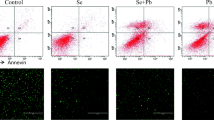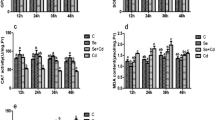Abstract
The purpose of this study was to investigate the effect of manganese (Mn)-induced cytotoxicity on heat shock proteins in chicken spleen lymphocytes. Lymphocytes were cultured in medium in the absence and presence of MnCl2 (2 × 10−4, 4 × 10−4, 6 × 10−4, 8 × 10−4, 10 × 10−4, and 12 × 10−4 mmol/L) for 12, 24, 36, and 48 h in vitro. Then, the mRNA levels of HSP27, HSP40, HSP60, HSP70, and HSP90 were examined by real-time quantitative PCR. The results showed that the mRNA levels of HSP27, HSP40, HSP60, HSP70, and HSP90 in all treatment groups at all time points, except mRNA levels of HSP27 at 48 h, had the same tendency. As manganese concentration increased, the mRNA expression of the heat shock proteins first increased and then decreased. In other words, we demonstrated that the mRNA expression of the heat shock proteins was induced at lower concentrations of manganese and was inhibited at higher concentrations. Mn had a dosage-dependent effect on HSP27, HSP40, HSP60, HSP70, and HSP90 mRNA expression in chicken spleen lymphocytes in vitro.





Similar content being viewed by others
Abbreviations
- Mn:
-
Manganese
- HSPs:
-
Heat shock proteins
- qPCR:
-
Real-time quantitative PCR
References
Aschner JL, Aschner M (2005) Nutritional aspects of manganese homeostasis. Mol Aspects Med 26(4–5):353–362
Hernández-Bonilla D, Schilmann A, Montes S, Rodríguez-Agudelo Y, Rodríguez-Agudelo S, Solís-Vivanco R, Ríos C, Riojas-Rodríguez H (2011) Environmental exposure to manganese and motor function of children in Mexico. Neurotoxicology 32(5):615–621
Aschner M, Guilarte TR, Schneider JS, Zheng W (2007) Manganese: recent advances in understanding its transport and neurotoxicity. Toxicol Appl Pharmacol 221(2):131–147
Fowler BA, Nordberg GF, Nordberg M, Friberg L (2011) Handbook on the toxicology of metals. Academic, San Diego
Homoncik SC, MacDonald AM, Heal KV, Dochartaigh BE O, Ngwenga BT (2010) Manganese concentrations in Scottish groundwater. Sci Total Environ 408(12):2467–2473
Yazbeck C (2011) Manganese: environmental exposure. Encycl Environ Health 612–616
Bowman AB, Kwakye GF, Herrero Hernández E, Aschner M (2011) Role of manganese in neurodegenerative diseases. J Trace Elem Med Biol 25(4):191–203
Röllin HB, Nogueira CMCA (2011) Manganese: environmental pollution and health effects. Encycl Environ Health 617–629
Ferraz HB, Bertolucci PHF, Pereira JS, Lima JGC, Andrade LAF (1988) Chronic exposure to the fungicide maneb may produce symptoms and signs of CNS manganese intoxication. Neurology 38(4):550–550
Liu XF, Li ZP, Tie F, Liu N, Zhang ZW, Xu SW (2013) Effects of manganese-toxicity on immune-related organs of cocks. Chemosphere 90(7):2085–2100
Myers JE, teWaterNaude J, Fourie M, Abie Zogoe HB, Naik I, Theodorou P, Tassel H, Daya A, Thoumpson LM (2003) Nervous system effects of occupational manganese exposure on South African manganese mineworkers. Neurotoxicology 24(4–5):649–656
Bagga P, Patel AB (2012) Regional cerebral metabolism in mouse under chronic manganese exposure: implications for manganism. Neurochem Int 60(2):177–185
Pinsino A, Matranga V, Trinchella F, Roccheri MC (2010) Sea urchin embryos as an in vivo model for the assessment of manganese toxicity: developmental and stress response effects. Ecotoxicology 19(3):555–562
Liu XF, Li ZP, Han CR, Zhang ZW, Xu SW (2012) Effects of dietary manganese on Cu, Fe, Zn, Ca, Se, IL-1β, and IL-2 changes of immune organs in cocks. Biol Trace Elem Res 148(3):336–344
Burger J, Gochfeld M (1995) Growth and behavioral effects of early postnatal chromium and manganese exposure in herring gull (Larus argentatus) chicks. Pharmacol Biochem Behav 50(4):607–612
Romano CC, Benedetto N, Catania MR, Rizzo A, Galle F, Losi E, Hasty DL, Rossano F (2004) Commonly used antibiotics induce expression of Hsp 27 and Hsp 60 and protect human lymphocytes from apoptosis. Intern Immunopharmacol 4(8):1067–1073
Gupta SC, Sharma A, Mishra M, Mishra RK, Chowdhuri DK (2010) Heat shock proteins in toxicology: how close and how far? Life Sci 86(11–12):377–384
Madrigal-Matute J, Martin-Ventura JL, Blanco-Colil LM, Egido J, Michel JB, Meilhac O (2011) Chapter1—Heat-shock proteins in cardiovascular disease. Adv Clin Chem 54:1–43
Shams S, Shafi S, Bodman-Smith K, Willitams P, Mehta S, Ferns GA (2008) Anti-heat shock protein-27 (Hsp-27) antibody levels in patients with chest pain: association with established cardiovascular risk factors. Clin Chim Acta 395(1–2):42–46
Hermenean AO, Tudor C, Postolache L, Munteanu MC, Serban AI, Costache M, Dinischiotu A (2010) Manganese (II) induced oxidative stress is counteracted by Hsp 27 and Hsp 70 in HepG2 cell line. Toxicol Lett 196:S307
Xing HJ, Li S, Wang X, Gao XJ, Xu SW, Wang XL (2013) Effects of atrazine and chlorpyrifos on the mRNA levels of HSP70 and HSC70 in the liver, brain, kidney and gill of common carp (Cyprinus carpio L.). Chemosphere 90(3):910–916
Brunt JJ, Khan S, Heikkila JJ (2012) Sodium arsenite and cadmium chloride induction of proteasomal inhibition and HSP accumulation in Xenopus laevis A6 kidney epithelial cells. Comp Biochem Physiol C Toxicol Pharmacol 155(2):307–317
Lebret T, William R, Watson G, Fitzpatrick JM (2003) Heat shock proteins: their role in urological tumors. J Urol 169(1):338–346
Clark JI, Muchowski PJ (2000) Small heat-shock proteins and their potential role in human disease. Curr Opin Struct Biol 10(1):52–59
Liu XF, Zhang LM, Zhang Z, Liu N, Xu SW, Lin HJ (2013) Manganese-induced effects on testicular trace element levels and crucial hormonal parameters of Hyline cocks. Biol Trace Elem Res 151(2):217–224
Rovetta F, Catalani S, Steimberg N, Boniotti J, Gilberti ME, Mariggio MA, Mazzoleni G (2007) Organ-specific manganese toxicity: a comparative in vitro study on five cellular models exposed to MnCl2. Toxicol In Vitro 21(2):284–292
Chen CJ, Liao SL, Huang YS, Chiang AN (2005) RhoA inactivation is crucial to manganese-induced astrocyte stellation. Biochem Biophys Res Commun 326(4):873–879
Kalmar B, Greensmith L (2009) Induction of heat shock proteins for protection against oxidative stress. Adv Drug Deliv Rev 61(4):310–318
Wu YJ, Cao ZM, Klein W, Luo Y (2010) Heat shock treatment reduces beta amyloid toxicity in vivo by diminishing oligomers. Neurobiol Aging 31(6):1055–1058
Yu ZJ, Yang XD, Wang K (2006) Metal ions induced heat shock protein response by elevating superoxide anion level in HeLa cells transformed by HSE-SEAP reporter gene. Toxicology 223(1–2):1–8
Steiner E, Kleinhappl B, Gutschi A, Marth E (1998) Analysis of hsp70 mRNA levels in HepG2 cells exposed to various metals differing in toxicity. Toxicol Lett 96–97:169–176
Huang PL, Chen CX, Wang H, Li GJ, Jing HM, Han Y, Liu N, Xiao Y, Yu QH, Liu YT, Wang PW, Shi ZX, Sun ZW (2011) Manganese effects in the liver following subacute or subchronic manganese chloride exposure in rats. Ecotoxicol Environ Saf 74(4):615–622
Son GH, Geum D, Chung S, Park E, Lee K, Choi S, Kim K (2005) A protective role of 27-kDa heat shock protein in glucocorticoid-evoked apoptotic cell death of hippocampal progenitor cells. Biochem Biophys Res Commun 338(4):1751–1758
Zhang QH, Zhang L, Xiao X, Su ZJ, Zou P, Hu H, Huang YD, He QY (2010) Heavy metals chromium and neodymium reduced phosphorylation level of heat shock protein 27 in human keratinocytes. Toxicol In Vitro 24(4):1098–1104
Black AT, Hayden PJ, Casillas RP, Heck DE, Gerecke DR, Sinko PJ, Laskin DL, Lasken JD (2011) Regulation of Hsp27 and Hsp70 expression in human and mouse skin construct models by caveolae following exposure to the model sulfur mustard vesicant, 2-chloroethyl ethyl sulfide. Toxicol Appl Pharmacol 253(2):112–120
Patel YJ, Payne Smith MD, Belleroche JD, Latchman DS (2005) Hsp27 and Hsp70 administered in combination have a potent protective effect against FALS-associated SOD1-mutant-induced cell death in mammalian neuronal cells. Mol Brain Res 134(2):256–274
Yang QL, Yao CL, Wang ZY (2012) Acute temperature and cadmium stress response characterization of small heat shock protein 27 in large yellow croaker, Larimichthys crocea. Comp Biochem Physiol C Toxicol Pharmacol 155(2):190–197
QiuXB SYM, Miao S, Wang L (2006) The diversity of the DnaJ/Hsp40 family, the crucial partners for Hsp70 chaperones. Cell Mol Life Sci 63(22):2560–2570
Zhu YF, Zhu JB, Wan XY, Zhu YP, Zhang TB (2010) Gene expression of sHsps, Hsp40 and Hsp60 families in normal and abnormal embryonic development of mouse forelimbs. Toxicol Lett 193(3):242–251
Kim SA, Chang SH, Yoon JH, Ahn SG (2008) TAT-Hsp40 inhibits oxidative stress-mediated cytotoxicity via the inhibition of Hsp70 ubiquitination. FEBS Lett 582(5):734–740
Park K, Bang HW, Park J, Kark IS (2009) Ecotoxicological multilevel-evaluation of the effects of fenbendazole exposure to Chironomus riparius larvae. Chemosphere 77(3):359–367
Park K, Kwak IS (2008) Characterization of heat shock protein 40 and 90 in Chironomus riparius larvae: effects of di(2-ethylhexyl) phthalate exposure on gene expressions and mouthpart deformities. Chemosphere 74(1):89–95
Brun NT, Bricelj VM, MacRae TH, Rae W, Ross NW (2008) Heat shock protein responses in thermally stressed bay scallops, Argopecten irradians, and sea scallops, Placopecten magellanicus. J Exp Mar Biol Ecol 358(2):151–162
Li CH, Li LY, Liu F, Ning XX, Chen A, Zhang LB, Wu HF, Zhao JM (2011) Alternation of Venerupis philippinarum Hsp40 gene expression in response to pathogen challenge and heavy metal exposure. Fish Shellfish Immunol 30(1):447–450
Zhou L, Xie JH, Ruan YY, Ruan YY, Zhu HY, Wang WZ, Yun XJ, Guo L, Gan HC, Sun LL, Yu M, Gu JX (2010) Expression and purification of secreted recombinant hsp60 from eukaryotic cells. Protein Expr Purif 72(2):179–183
Wheeler DS, Lahni P, Odoms K, Jacobs BR, Carcillo JA, Doughty LA, Wong HR (2007) Extracellular heat shock protein 60 (Hsp60) levels in children with septic shock. Inflamm Res 56(5):216–219
Xu QB, Schett G, Perschinka H, Mayr M, Egger G, Oberhollenzer F, Willeit J, Kiechi S, Wich G (2000) Serum soluble heat shock protein 60 is elevated in subjects with atherosclerosis in a general population. Circulation 102(1):14–20
Guecheva TN, Erdtmann B, Benfato MS, Henriques JAP (2003) Stress protein response and catalase activity in freshwater planarian Dugesia (Girardia) schubarti exposed to copper. Ecotoxicol Environ Saf 56(3):351–357
Kohler HR, Alberti G, Seniczak S, Seniczak A (2005) Lead-induced hsp70 and hsp60 pattern transformation and leg malformation during postembryonic development in the oribatid mite, Archegozetes longisetosus Aoki. Comp Biochem Physiol C Toxicol Pharmacol 141(4):398–405
Zhou J, Wang WN, He WY, Zheng Y, Wang L, Xin Y, Liu Y, Wang AL (2010) Expression of HSP60 and HSP70 in white shrimp, Litopenaeus vannamei in response to bacterial challenge. J Invertebr Pathol 103(3):170–178
Su XR, Du LL, Li YY, Li Y, Zhou J, Li TW (2010) Cloning and expression of HSP70 gene of Sipuncula Phascolosoma esculenta. Fish Shellfish Immunol 28(3):461–466
Roccheri MC, Agnello M, Bonaventura R, Matranga V (2004) Cadmium induces the expression of specific stress proteins in sea urchin embryos. Biochem Biophys Res Commun 321(1):80–87
Planello R, Martinez-Guitarte JL, Morcillo G (2010) Effect of acute exposure to cadmium on the expression of heat-shock and hormone-nuclear receptor genes in the aquatic midge Chironomus riparius. Sci Total Environ 408(7):1598–1603
Franzellitti S, Fabbri E (2005) Differential HSP70 gene expression in the Mediterranean mussel exposed to various stressors. Biochem Biophys Res Commun 336(4):1157–1163
Shu YH, Du Y, Wang JW (2011) Molecular characterization and expression patterns of Spodoptera litura heat shock protein 70/90, and their response to zinc stress. Comp Biochem Physiol A Mol Integr Physiol 158(1):102–110
Padmini E, Rani MU (2009) Seasonal influence on heat shock protein 90α and heat shock factor 1 expression during oxidative stress in fish hepatocytes from polluted estuary. J Exp Mar Biol Ecol 372(1–2):1–8
Workman P (2004) Combinatorial attack on multistep oncogenesis by inhibiting the Hsp90 molecular chaperone. Cancer Lett 206(2):149–157
Choi YK, Jo PG, Choi CY (2008) Cadmium affects the expression of heat shock protein 90 and metallothionein mRNA in the Pacific oyster, Crassostrea gigas. Comp Biochem Physiol C Toxicol Pharmacol 147(3):286–292
Acknowledgments
We express our sincere appreciation to all the participants of this study. This work was supported in part by a grant from the Doctoral Program Fund of Institutions of Higher Education of China (no. 2010RCB32), China.
Author information
Authors and Affiliations
Corresponding authors
Additional information
All authors have read the manuscript and have agreed to submit it in its current form for consideration for publication in the journal.
Rights and permissions
About this article
Cite this article
Zhu, Y., Lu, X., Wu, D. et al. The Effect of Manganese-induced Cytotoxicity on mRNA Expressions of HSP27, HSP40, HSP60, HSP70 and HSP90 in Chicken Spleen Lymphocytes in Vitro. Biol Trace Elem Res 156, 144–152 (2013). https://doi.org/10.1007/s12011-013-9817-2
Received:
Accepted:
Published:
Issue Date:
DOI: https://doi.org/10.1007/s12011-013-9817-2




